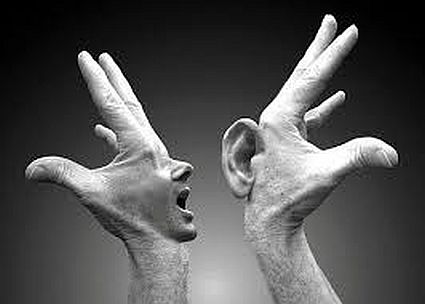The 7 Habits Of Highly Effective People was originally published on August 15, 1989. Habit 5 starts with, “Seek first to understand……” It’s foundational to everything we do, whether in our business, community, or personal relationships. Yet it seems to be one of the most difficult habits to live by. And it is one of the most important habits for us to exercise in learning, growing, and achieving our objectives.
Despite how well intended we are, too often, we make assumptions or leap to conclusions, without first understanding.
We may have a well defined ICP, we know the key issues customers are likely to face. We reach out, “We provide solutions to customers, like you, who need to……”
Or we disguise it as insight, “This is a huge issue for organizations like yours…..”
With our people, we see the performance data coming to the conclusion, “Dave, you are struggling with this……, why don’t you try doing that…….?”
We may be very accurate about our observations and analysis, but we miss the most important agreement—we haven’t sought to understand.
In seeking to understand, we are trying to learn about the people with whom we interact. What do they view as the challenges and priorities in achieving their goals? How do these things impact their day to day jobs/performance? What are their dreams, goals, aspirations? How do they get their work done? What do they……..?
Whether it’s our customers, our peers, our people, until we understand them–what drives them, how they think about things, how they get their work done, what’s important to them; we can’t connect effectively with them.
But there’s a magic, overlooked outcome to taking the time to understand the people we are engaging. T
It’s amazing how, when we start “seeking first to understand,” how much it impacts those we are trying to connect with. First, there is the genuine interest, empathy, connection. But these conversations help the people we are engaging think and reflect for themselves.
In the rush of every day, we sometimes lose sight of what’s important, what we want do achieve, what we need to focus on. We lose track of what we are trying to do.
Recently, I’ve had a team of students conducting 100’s of interviews with sales executives. The interviews focus on understanding them, their roles, challenges, and so forth. While the students are learning a huge amount about these executives, the feedback from the executives has been fascinating:
“No one has ever asked me these questions before……..”
“I’ve never asked myself these questions before….”
It turns out, when we seek first to understand, we help them better understand for themselves. And this becomes the foundation to any discussion in which we explore how we change, move forward and achieve more.
Our research and targeting helps in the first steps of understanding. We understand a role, a market, an industry, a company, perhaps a little about the individual. But until we have the conversations, we don’t understand, we don’t help those we engage to understand.
While we might have insights that begin our conversations, until we connect with the individual, asking, “How is this impacting you,” we don’t connect and engage in the most impactful ways.
And our customers and people constantly remind us of the importance of this principle. Our customers prefer not to see sellers, because they don’t understand and aren’t helpful. Our people are, increasingly, disengaged because we don’t understand them and what they care about.
As “unfashionable” as it is–reflecting back to the Stone Ages of 1989, the importance of this principle remains one of the most important to us, as individuals, and everyone we seek to engage.
“Seek first to understand, then to be understood.”
Understanding isn’t passive! It requires curiosity and active engagement.
Afterword: Here is the AI generated discussion of this post. I’m embarrassed to confess this, but it’s better than the article. Enjoy!

Combining Covey’s insight (or earlier) about seeking to understand with Cialdini’s (or earlier) about reciprocity, we get “if we seek first to understand, others will naturally then seek to understand us in return.”
I wonder if the sales experts from the 80s and 90s had some insights we have since tended to forget?
Sadly, the main 80’s insight was
“Two ears and one mouth, use them in that proportion.”
Like most clichés it was ignored, and when observed, was ineffective.
Not talking is not listening, but overtalking the buyer
clearly signals “I’m not listening”
Good listening begins with Good Questions.
AI offers the list:
Active listeners show empathy, patience, and genuine interest.
They don’t interrupt, they ask clarifying questions, and they often paraphrase to ensure understanding.
Active listeners also use non-verbal cues like nodding, maintaining eye contact, and leaning forward to show engagement.
Also, they’re able to avoid jumping to conclusions or judgments and focus solely on understanding the speaker’s perspective.
In the best conversations, you can almost feel how present and attentive they are. Makes a world of difference, doesn’t it?
Indeed it does!
I have sat through thousands of Sales calls as an Observer.
I have to complete a Tick-sheet of Seller-Buyer behaviours.
I log against between 12 and 16 behaviour categories,
but can identify up to 32 distinct verbal Behaviours,
with an accuracy of above 85%.
While observing I do not talk, I do not prepare, or rehearse, responses in my head, I simply listen. As I became more and more proficient I was astonished at how much Sellers AND Buyers missed.
One of the training exercises I do is to record and replay the call with the Salesperson afterwards. They are astonished at how much they missed.
The move from unconscious incompetent to conscious incompetent,
then we can begin to build competence.
‘Proficient Listening’ requires a LOT of practice,
and a good deal of behavioural modification.